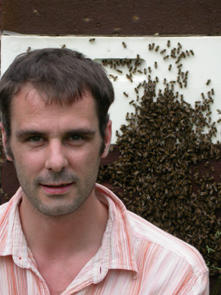Dr. Gérard Leboulle

Researcher until 2015
Molecular biology of sensory perception and synaptic plasticity in the honeybee
Research Goals
My research is directed towards the understanding of the molecular mechanisms related to sensory perception, neural plasticity underlying learning and memory and complex behaviour in the honeybee Apis mellifera.
As in other animals species memory is a dynamic process taking place in different brain regions at defined times during and after initial learning. Memory consolidation is composed of different phases that develop in parallel and are expressed at specific times after learning. These phases might develop independently from each other and rely on specific neurotransmitter systems and signalling cascades.
The honeybee presents several advantages to tackle these memory mechanisms: Bees have a relatively simple nervous system composed of about one million neurons and a limited number of neuroanatomical regions. We localise histologically selected gene candidates specific for neurotransmitter systems and signalling pathways in order to understand brain architecture; asking at the system’s level, how neural networks are organised and interconnected, and at the sub-cellular level, how signalling cascades are spatially distributed within neurons.
The honeybee has great learning capabilities that can be studied under laboratory conditions by using the proboscis extension response conditioning, a robust appetitive classical conditioning procedure. Single animals trained with this paradigm strongly express memory phases that are well characterised and differentiated in time. We down regulate the expression of the selected gene candidates by molecular techniques, and study their role in sensory perception, learning and memory, taking into consideration the spatio-temporal aspects of their activations.
The honeybee is a eusocial species with a rich behavioural repertoire. Different castes compose the colony, allowing us to study the molecular underpinning of colony organisation and social interactions. We describe gene expression profiles associated with specific behaviours, and we extend the study of our selected gene candidates to elucidate their particular role(s) in complex behaviours.
Special emphasis is given to the development of molecular tools interfering specifically with gene expression. We use RNA interference (RNAi) to inhibit gene expression, and attempt to transfect in vivo brain neurons of adult honeybees with functional expression vectors.
Research background
During my PhD at the Free University of Brussels, I worked in the field of applied immuno-parasitology. I identified bioactive factors produced by the tick, Ixodes ricinus, which modulate host defences (haemostasis and immunity) and facilitate the transmission of the bacterium Borrelia burgdorferi, the causal agent of Lyme disease. The identified factors could serve the development of new drugs for human health and help to combat tick-borne diseases. Different cDNA libraries were set up to identify the factors of interest. The recombinant proteins of a few selected clones were produced in several expression systems and we characterised their immunomodulatory properties. A pilot experiment of DNA vaccination evaluated if mice were protected from ticks infestation and Borrelia burgdorferi infection. During this project, we collaborated with a Swiss group and I accomplished several journeys in Switzerland. The results were further exploited and a spin-off company was recently set-up to valorise interesting factors.
In the second phase of my career, I specialised in neurobiology at the Free University of Berlin. I contributed to the study of the cAMP-dependent second messenger pathway, an intracellular signalling cascade implicated in many neuronal processes. I studied the activation modalities of the cAMP-dependent protein kinase (PKA – collaboration with Prof. U. Müller) and contributed to the annotation process of the genome by focusing on the PKA and CREB gene families (collaboration with Prof. D. Eisenhardt). My participation to the genome project introduced me to the "honeybee community". In a project on the visual system in collaboration with Dr. N. Hempel de Ibarra, we described some aspects of visual perception and characterised the long-wavelength photoreceptor. This project combined behaviour, electrophysiology and RNAi.
The knowledge about the organisation of the different neurotransmitter networks composing the brain is limited. The glutamatergic transmission retained most of our attention, in particular NMDA glutamate receptor and inhibitory glutamate chloride channel (GluCl – collaboration with Dr. C. Armengaud). We localised within the brain at the protein and mRNA levels the NR1 subunit of the NMDA glutamate receptor and the GluCl a subunit and studied their role in learning and memory by applying an RNAi-based strategy. We showed that GluCl is important for the retrieval of memory and NMDA glutamate receptor plays a role in the formation of early memory phases leaving a late phase intact, in appetitive conditioning.
In a joint-project with the groups of Prof. M. Beye, Prof. N. Reinsch, Prof. K. Bienefeld, we studied hygienic behaviour. This applied project aimed towards the development of diagnostic tools for the selection of disease resistant honeybees. For a few years, the number of honeybee colonies has been decreasing continuously in Europe. One reason for this is pests and pathogens affecting honeybee brood (e.g. the mite Varroa destructor, the fungus Ascosphaera apis). Some honeybees present a hygienic behaviour, meaning that they are able to detect and discard infested brood. This behaviour has a strong genetic component that can most directly be described as relative changes of gene products in the nervous system. For this reason, we compared the full transcriptome profiles of hygienic and non-hygienic honeybee brains by applying DNA array. The specificity of some identified genes for the hygienic phenotype was confirmed by RT-qPCR.
Current projects
Our results on the role of the NMDA glutamate receptor in the bee brain are surprising because other studies showed that the receptor is required for learning, thus for the development of all memory phases. Inhibition induced by RNAi was of moderate amplitude and it was limited in time and space. One goal is to evaluate whether these limitations explain the lack of effect on the late memory phase. We are also considering other neuronal calcium sources (voltage-gated calcium channels) and components of signalling pathways implicated in local protein translation (the target of rapamycine, eukaryotic elongation factor 2). We study their role in the different memory phases, and whether they are connected to the NMDA glutamate receptor signalling pathway. We investigate GluCl of different brain regions and ask if they are implicated in sensory perception and synaptic plasticity by combining RNAi and eletrophysiology (collaboration with Prof. R. Menzel and Ruth Bartels). In a collaboration with Prof. C. Scharff and Adriana Schatton, we localise components of neurotransmitter systems (classical, modulatory and neuropeptide transmitters) by in situ hybridisation in order to better understand the architecture of the brain. Our previous RNAi protocol is particularly helpful in these studies. However, we also successfully apply expression systems based on in vivo electroporation and on viral vectors. We further develop these techniques and take advantage of them in our behavioural studies.
Group members
Julia Agoro – Research volunteer
Scientific collaborations
Prof. Constance Scharff (Free University of Berlin, Germany)
Prof. Randolf Menzel (Free University of Berlin, Germany)
Dr. Natalie Hempel de Ibarra (University of Exeter, United Kingdom)
Prof. Hans-Joachim Pflüger (Free University of Berlin, Germany)
Prof. Martin Beye (Heinrich Heine University, Germany)
Techniques
Subtractive and ‘full length’ cDNA libraries. Recombinant proteins expression, in vitro activity tests and DNA vaccination. In situ hybridisation and immunohistochemistry. Western blot, ELISA and real-time PCR. Induction of RNAi, in vivo electroporation and viral-based expression system. Microarray. Behavioural tests.
Publications
- El Hassani A.K., Schuster S., Dyck Y., Demares F., Leboulle G.*, Armengaud C.*: "Identification, Localization and Function of Glutamate-Gated Chloride Channel Receptors in the Honeybee Brain" (2012) - European J. Neuroscience – 36(4): 2409-2420 *equal contributors
- Müßig L., Richlitzki A., Rößler R., Eisenhardt D., Menzel R., Leboulle G.: Acute Disruption of the NMDA Receptor Subunit NR1 in the Honeybee Brain Selectively Impairs Memory Formation (2010) J. Neuroscience 30(23): 7817-7825
- Niggebrugge C., Leboulle G., Menzel R., Komischke B., Hempel de Ibarra, N.: Fast learning but coarse discrimination of colours in restrained honeybees (2009) J. Exp. Biol. 212(9): 1344-1350.
- Daix V., Praet N., Georgin J.-P., Chiappino I., Gillet L., Defays K., Decrem Y., Leboulle G., Godfroid E., Bollen A., Pastoret P.-P., Gern L., Sharp P. M., Vanderplasschen A. Ixodes ticks encode a new family of anti-complement proteins" (2007) – Insect Mol. Biol. – 16(2): 155-166.
- Niggebruegge C., Hempel de Ibarra N., Komischke B., Leboulle G., Menzel R.: Classical conditioning of coloured stimuli in the honeybee, Apis mellifera (2006) Perception 35: 138-139 Supplement: S
- Bee Genome Sequencing Consortium, (2006) Insights into social insects from the genome of the honeybee, Apis mellifera. Nature 443 (7114): 931-949. Dorothea Eisenhardt and Gérard Leboulle are co-authors of this publication.
- Eisenhardt, D., Kühn,C.; Leboulle, G. (2006) The PKA-CREB system encoded by the honeybee genome. Insect Molecular Biology 15(5): 551-561.
- Zannat M.T., Locatelli F., Rybak J., Menzel R., Leboulle G. Identification and localisation of the NR1 sub-unit homologue of the NMDA glutamate receptor in the honeybee brain (2006). Neurosci Lett. 398: 274-279.
- Menzel R., Leboulle G., Eisenhardt D. Small brains, bright minds (2006). Cell 124(2): 237-9.
- Leboulle G., Müller U. Synergistic activation of insect cAMP-dependent protein kinase A (type II) by cyclicAMP and cyclicGMP (2004). FEBS letters 576: 216-220.
- Leboulle G., Crippa M., Decrem Y., Mejri N., Brossard M., Bollen A. and Godfroid E.: Characterization of a novel salivary immunosuppressive protein from Ixodes ricinus ticks (2002). J. Biol. Chem. 277: 10083-10089.
- Leboulle G., Rochez C., Louahed J., Rutti B., Brossard M., Bollen A., and Godfroid E.: Isolation of Ixodes ricinus salivary gland mRNA encoding factors induced during blood feeding (2002). Am. J. Trop. Med. & Hyg. 66(3): 225-233.



